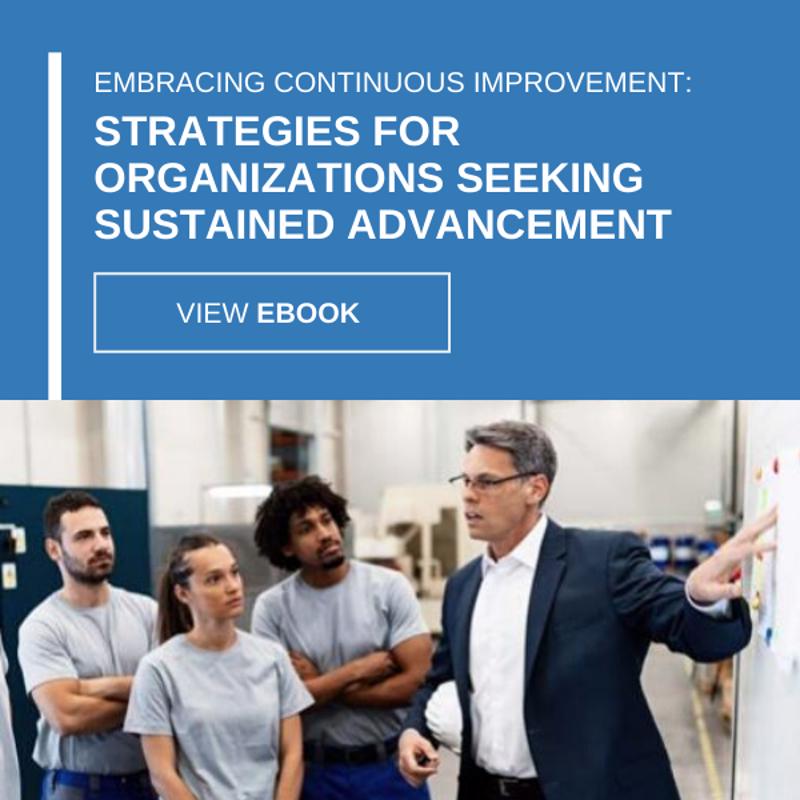
Why People Matter Most to Continuous Improvement
Is successful continuous improvement a top-down or bottom-up initiative? Ask lean manufacturing experts and they’re likely to equivocate. It’s not really one or the other in all cases. It’s both and neither at the same time.
Good CI doesn’t have managers that dictate new laws from on high, nor does it have ungoverned employees who change processes as they see fit. If anything, the best CI is more bi- or tricameral, or maybe even “middle-out.” Unfortunately, this ambiguity can undermine a CI program before it truly rolls out. Focusing on people, however, can bring remarkable clarity.

Hub-and-spoke model for continuous improvement
Picture a business as if it were a wheel, with executives at the hub, rank-and-file workers around the outer tire, and middle management as the spokes connecting the two. CI can come from the C-suite, where concentrated experience informs initiatives. CI can also come from workers who have valuable first-hand experience with assets and workflows. Finally, middle management can also lead CI by noticing problems at the hub or the tire that neither party can identify on its own.
But regardless of which direction CI flows, everyone agrees that people are the most important drivers of strong, reliable CI systems; ideas for improvement emanate from operators on the shop floor, managers in the back offices and executives in the boardroom to the rest of the business. Therefore, a company that empowers its employees simultaneously empowers its CI.
Why is that, and what can businesses that lack people power do to strengthen buy-in?
Cross-functional involvement: The other CI
An earmark of any CI initiative is the preference of long-term positioning over short-term gains. Rather than push through a change that might net a fleeting financial return, CI challenges businesses to restructure in ways that perpetually grow revenue, eliminate wasteful actions, and capably report on progress regarding both.
This horizon-line vision, however preferential to shortsightedness, conceals one crucial component of CI: At the end of the day, process improvements are carried out by people, all of whom have ideas and opinions about what’s new and what’s passed. Clashes are sometimes unavoidable. As they say, you can’t please everyone all the time.
What’s more important than satisfying professional egos, however, is remembering that every CI-related decision, no matter how small, affects the entire business. Companies must build cross-functional involvement into its general CI process, preferably during the initial strategic planning meetings. By considering everyone at the outset of every CI project, businesses retain one of the greatest tools for ensuring CI success. No one person or department should monopolize ideation.
With that said, project managers must act as countervailing forces to stakeholders and their input. They alone must place the recommendations of each into the context of the greater CI mission to justify their effect on how any given project is carried out.
Timeliness is as important as insight
According to an oft-cited survey of 137 enterprise managers conducted by renowned professors of quality management Clinton Longenecker and Joseph Scazzero, three of the top five reasons why businesses fail to uphold quality include “communication breakdowns,” “ineffective corrective action procedures,” and “lack of teamwork/conflict.”
What does that tell us about CI, which is arguably all about managing quality? CI isn’t only about what your team knows but how quickly and completely your team acts on what it knows. A business with a suggestion box emptied once a year takes, at best, a year and a day to make a single change. We all can and should aspire to much better.
Consummate advocacy among cross-functional team members makes for not only excellent ideas on how to change, but also excellent ideas for how to prioritize and implement change. Once businesses have nailed down how they ignite possible improvement projects and collaborate among relevant stakeholders, they must then lay the groundwork for frictionless execution, be it through daily meetings before every shift, efficient documentation, and/or redefining employee hierarchies regarding who reports to whom.
Again, we ask that you exercise caution and moderation. When it comes to CI project workflow, you don’t want too many restrictions preventing your team from completion, but you don’t want unrestricted processes either. Instead, take a phased approach, sometimes referred to as a gated approach: Once first steps are wholly finished, then everyone can move onto next steps.
Speak to the operations management consulting experts at USC Consulting Group to learn more about how to drive the fundamentals of continuous improvement at your business.






